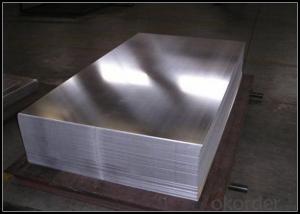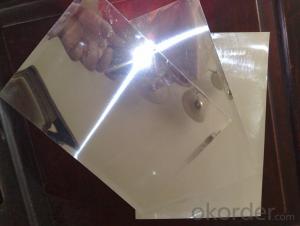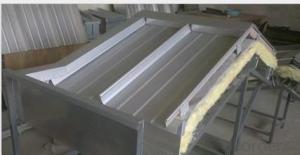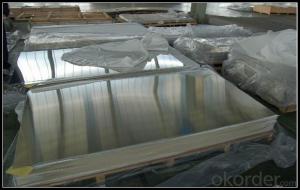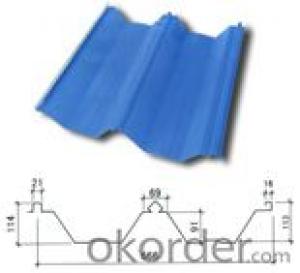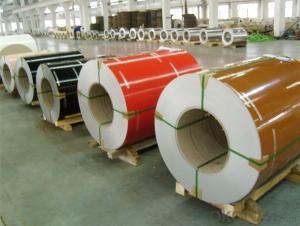Colored Corrugated Aluminum Alloy Sheets for Metal Wall Systems in Las Vegas
- Loading Port:
- Shanghai
- Payment Terms:
- TT OR LC
- Min Order Qty:
- 5 m.t.
- Supply Capability:
- 10000 m.t./month
OKorder Service Pledge
OKorder Financial Service
You Might Also Like
Specification
1. Specification of Corrugated Aluminum Alloy Sheets for Metal Wall Systems
Alloy Number | AA5XXX |
Temper | H12, H14, H16, H18, H22, H24, H26, H32, HO, F |
Thickness | 0.1mm – 500mm |
Width | 10mm- 2200mm |
Standard | GB/T3880-2006, ASTM, ISO, EU standard |
2. Application of Corrugated Aluminum Alloy Sheets for Metal Wall Systems
(1).Interior: wall cladding, ceilings, bathrooms, kitchens and balconies, shutters, doors...
(2).Exterior: wall cladding, facades, roofing, canopies, tunnels,column covers , renovations...
(3).Advertisement: display platforms, signboards, fascia, shop fronts...
3. Feature of Corrugated Aluminum Alloy Sheets for Metal Wall Systems
Surfact Quality :
Be free from Oil Stain, Dent, Inclusion, Scratches, Stain, Oxide Dicoloration, Breaks, Corrosion, Roll Marks, Dirt Streaks and other defect which will interfere with use,
Mechenical Property:
Chemical Composite and Mechanical Property
4. Certificate:
SGS and ROHS(if client request, paid by client), MTC(plant provided), Certificate of Origin(FORM A, FORM E, CO), Bureau Veritas and SGS (if client request, paid by client), CIQS certificate
5. Image of Corrugated Aluminum Alloy Sheets for Metal Wall Systems
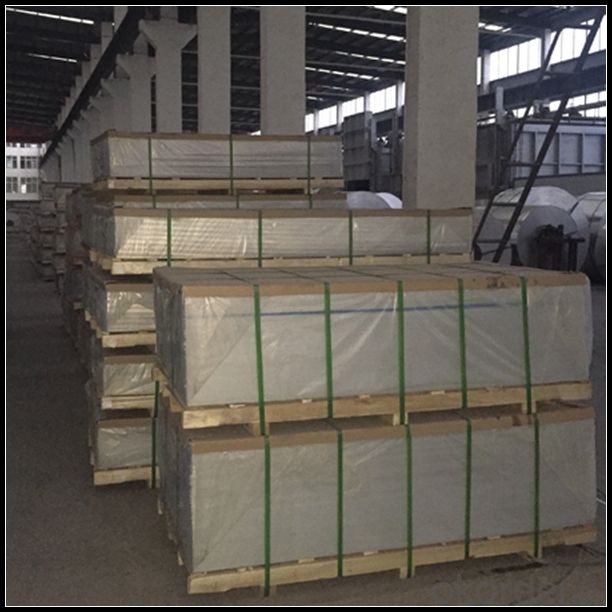
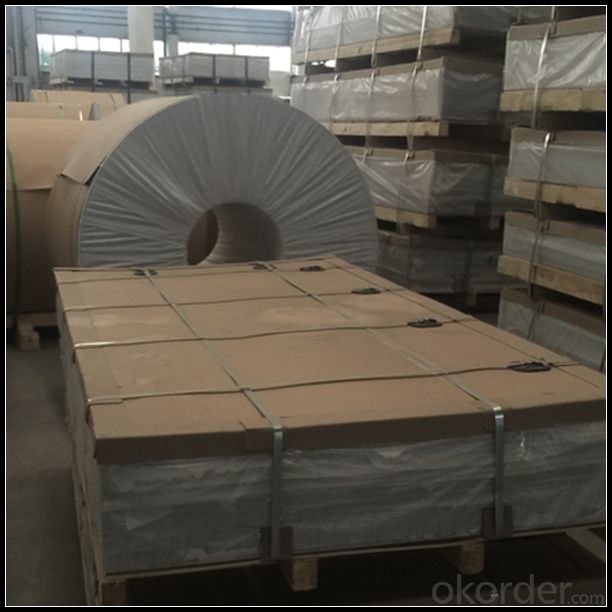
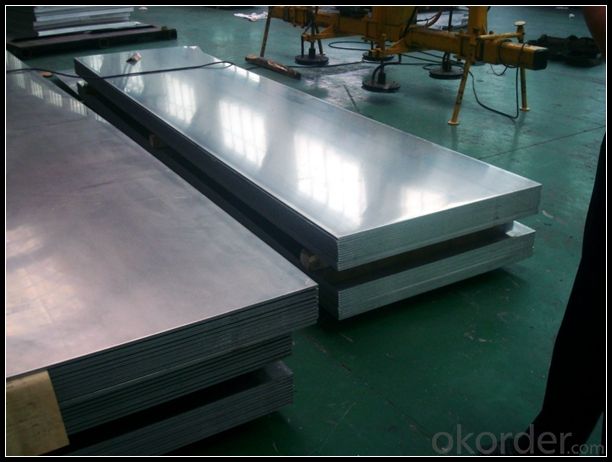
6. Package and shipping of Corrugated Aluminum Alloy Sheets for Metal Wall Systems
First, plastic cloth with drying agent inside; Second, Pearl Wool ; Third, wooden cases with dry agent , fumigation wooden pallets, aluminum surface could cover blue PVC film
7. FAQ
1) What is the delivery time?
Dpends on actual order, around 20 to 35 days
2)What is the QC system:
We have QC staff of 20 persons and advanced equipment, each production is with MTC traced from Aluminum ingot lot.
3) What market do you mainly sell to?
Australia, America, Asia, Middle East, Western Europe, Africa etc
- Q: Can aluminum sheets be recycled?
- Yes, aluminum sheets can be recycled. Aluminum is a highly recyclable material, and recycling aluminum sheets helps in conserving natural resources and reducing energy consumption compared to producing new sheets from raw materials.
- Q: Can aluminum sheets be used for packaging?
- Aluminum sheets have the ability to be utilized for packaging purposes. The packaging industry highly values aluminum due to its numerous advantageous properties, as it is a versatile and extensively used material. The lightweight nature, strength, durability, and resistance to corrosion of aluminum make it an optimal choice for packaging applications. By using aluminum sheets, it is effortless to mold them into various shapes and sizes, offering the advantage of design flexibility and customization. In addition, aluminum possesses impermeability to light, moisture, gases, and microorganisms, guaranteeing the safety and preservation of the packaged goods. Its exceptional heat conductivity also allows for efficient heat transfer during processes like sterilization or pasteurization. Moreover, aluminum is environmentally friendly as it can be recycled, making it a sustainable option for packaging. All in all, aluminum sheets are a remarkable choice for packaging purposes due to their exceptional properties and versatility.
- Q: Can the aluminum sheets be used for manufacturing heat sinks?
- Yes, aluminum sheets can be used for manufacturing heat sinks. Aluminum is a popular choice for heat sinks due to its excellent thermal conductivity properties. It is lightweight, has high electrical conductivity, and is easily machinable, making it an ideal material for dissipating heat from electronic components. Aluminum sheets can be easily formed, cut, and shaped into the desired heat sink design, allowing for efficient heat transfer and dissipation. Additionally, aluminum is corrosion-resistant, which ensures the longevity and reliability of the heat sink. Overall, aluminum sheets are commonly used in the manufacturing of heat sinks for various applications in industries such as electronics, automotive, and aerospace.
- Q: How thick can aluminum sheets be?
- Aluminum sheets can vary in thickness depending on the specific application and requirements. Generally, aluminum sheets are available in thicknesses ranging from 0.008 inches (0.2 mm) to 0.25 inches (6.35 mm) or even thicker for specialized industrial applications. However, it's important to note that aluminum sheets thicker than 0.25 inches are less common and may require custom manufacturing or special orders. Ultimately, the thickness of an aluminum sheet is determined by the intended use, structural requirements, and the overall feasibility of the manufacturing process.
- Q: This question asks for a list of adhesive types that are suitable for bonding aluminum sheets. It is important to provide a variety of options to give a comprehensive answer.
- <p>There are several types of adhesives used for bonding aluminum sheets together, including epoxy resins, which offer strong adhesion and resistance to heat and chemicals; polyurethane adhesives, known for their flexibility and durability; acrylic adhesives, which provide good adhesion and are easy to use; cyanoacrylates or 'super glues,' which bond quickly and are great for small, precise applications; and silicone adhesives, which are excellent for high-temperature applications and offer flexibility. Each type has its own advantages and is chosen based on the specific requirements of the bonding task, such as strength, flexibility, and resistance to environmental factors.</p>
- Q: Can aluminum sheets be used for honeycomb panels?
- Indeed, honeycomb panels can indeed utilize aluminum sheets. To create honeycomb panels, it is customary to bond two slender sheets of material, like aluminum, to a core material in a honeycomb formation. Aluminum sheets are frequently employed in this process due to their advantageous traits of being lightweight and possessing high strength, rendering them an optimal selection for constructing honeycomb panels. The honeycomb structure itself results in a superior strength-to-weight ratio, rendering the panels suitable for an array of applications, encompassing aerospace, automotive, construction, and furniture industries. In addition to this, the aluminum sheets offer desirable attributes such as durability, resistance to corrosion, and ease of fabrication, thereby making them a widely favored option for honeycomb panels.
- Q: How are aluminum sheets manufactured?
- Aluminum sheets are manufactured through a process called rolling, where aluminum billets are heated and passed through a series of rolling mills to reduce their thickness. The billets are first heated to a specific temperature and then rolled multiple times, with each pass reducing the thickness of the sheet until the desired gauge is achieved. The process also involves annealing, where the sheets are heat-treated to improve their strength and flexibility. Finally, the sheets are cut to the desired length and width before being packaged for distribution.
- Q: This question asks for a detailed explanation of the steps involved in the manufacturing process of aluminum profiles specifically designed for use as exterior cladding.
- <p>The process for manufacturing aluminum profiles for exterior cladding involves several key steps. First, aluminum ingots are melted in a furnace. The molten aluminum is then poured into molds to create extrusion billets. These billets are heated and fed into an extrusion press where they are forced through a die with the desired profile shape. After extrusion, the profiles are cooled and then cut to length. They may undergo further processing such as anodizing, painting, or powder coating to enhance their durability and appearance. Finally, the profiles are inspected for quality, packaged, and shipped to construction sites for installation as exterior cladding.</p>
- Q: What are the different methods of surface cleaning aluminum sheets?
- There are several methods for surface cleaning aluminum sheets, depending on the level of dirt or contamination present. Here are some of the most commonly used methods: 1. Mechanical Cleaning: This method involves physically scrubbing the surface of the aluminum sheet using brushes, abrasive pads, or sandpaper. It is effective for removing light dirt, grease, or oxidation. However, caution should be exercised to avoid scratching or damaging the surface. 2. Chemical Cleaning: Chemical cleaning involves the use of specific cleaning agents or solutions to remove dirt, stains, or oxidation from the aluminum sheet. Commonly used chemicals include alkaline cleaners, acidic cleaners, and solvents. It is important to follow the manufacturer's instructions and take necessary safety precautions when working with chemicals. 3. Pressure Washing: Pressure washing utilizes high-pressure water jets to remove dirt, grime, and other contaminants from the surface of aluminum sheets. It is a quick and efficient method, particularly for large or heavily soiled surfaces. However, care should be taken to avoid using excessive pressure, which may dent or damage the aluminum. 4. Electrolytic Cleaning: This method involves the use of an electrolyte solution and an electric current to remove corrosion, oxidation, or tarnish from the aluminum sheet. The sheet is submerged in the electrolyte bath, and the electric current helps to dissolve the contaminants. Electrolytic cleaning is particularly effective for heavily oxidized or tarnished surfaces. 5. Chemical Etching: Chemical etching is a process that uses a combination of chemicals to selectively remove the surface layer of the aluminum sheet. It is commonly used for removing anodized coatings or for creating decorative patterns on the surface. However, this method requires specialized equipment and expertise. It is important to note that the choice of cleaning method should be based on the specific requirements of the aluminum sheet, the level of contamination, and the desired outcome. It is always recommended to consult the manufacturer's guidelines or seek professional advice to ensure the most appropriate and safe cleaning method is used.
- Q: 5052 aluminum plate and LY12 aluminum plate is the same?
- The 5052 series is aluminum magnesium alloy, the magnesium alloy belongs to the lower density alloy, the 5052 alloy aluminum plate density is 2.68
Send your message to us
Colored Corrugated Aluminum Alloy Sheets for Metal Wall Systems in Las Vegas
- Loading Port:
- Shanghai
- Payment Terms:
- TT OR LC
- Min Order Qty:
- 5 m.t.
- Supply Capability:
- 10000 m.t./month
OKorder Service Pledge
OKorder Financial Service
Similar products
Hot products
Hot Searches
Related keywords
